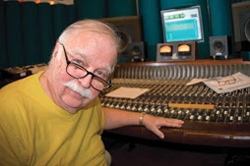Bruce Swedien is truly the godfather of recording engineers, having recorded and mixed hits from everyone from Count Basie, Duke Ellington and Dizzy Gillespie to Barbra Streisand, Donna Summer and Michael Jackson.
He’s a mentor of mentors, as so many of his teachings are now handed down to a generation now just learning (his interview in The Mixing Engineer’s Handbook is a standout).
Bruce is also a collector of microphones and will not use one he doesn’t personally own, so he knows the exact condition of each.
Recently he posted a bit about the mics he uses on his Facebook page, and I thought it worth a reprint.
A few things stick out to me:
1. His use of an Sennheiser 421 on kick. I know it’s a studio standard for some reason (especially on toms), but I never could get it work on anything in a way that I liked.
2. His use of the relatively new Neumann M149, because it’s eh………..new.
3. His synthesizer advice (under the M49) is a real gem.
Here’s Bruce.
——————————————————————
“Constantly being asked about my mics, so here goes:
“My microphone collection, spanning many of the best-known models in studio history, are my pride and joy. My microphones are prized possessions. To me, they are irreplaceable. Having my own mics that no-one else handles or uses assures a consistency in the sonics of my work that would otherwise be impossible.”
AKG C414 EB
“My first application would be for first and second violins. It’s really great mic for the classical approach for a string section.”
Hear it on… the first and second violins in Michael Jackson’s ‘Billie Jean.’
Altec 21B
“This is a fantastic mic, and I have four of them. It’s an omni condenser, and [for jazz recording] what you do is wrap the base of the mic connector in foam and put it in the bridge of the bass so that it sticks up and sits right under the fingerboard. It wouldn’t be my choice for orchestral sessions, though.”
Hear it on… Numerous recordings for Oscar Peterson between 1959 and 1965.
RCA 44BX & 77BX; AEA R44C
“[The 44BX] is a large, heavy mellow-sounding old mic with a great deal of proximity effect. This is very useful in reinforcing the low register of a vocalist’s range if that is desired. If I am asked to do a big band recording of mainly soft, lush songs, I almost always opt for ribbon mics for the brass. I suggest AEA R44C or RCA44BX on trumpets, and RCA 77DX on trombones. Ribbon mics are great for percussion too.”
Hear it on… trumpets and flugelhorns in Michael Jackson’s ‘Rock With You’ (at 0:54); percussion in Michael Jackson’s ‘Don’t Stop Till You Get Enough.’
Sennheiser MD421
“The kick is about the only place I use that mic, and I mike very closely. I frequently remove the bass drum’s front head, and the microphone is placed inside along with some padding to minimise resonances, vibrations, and rattles.”
Hear it on… the kick drum in Michael Jackson’s ‘Billie Jean.’





















